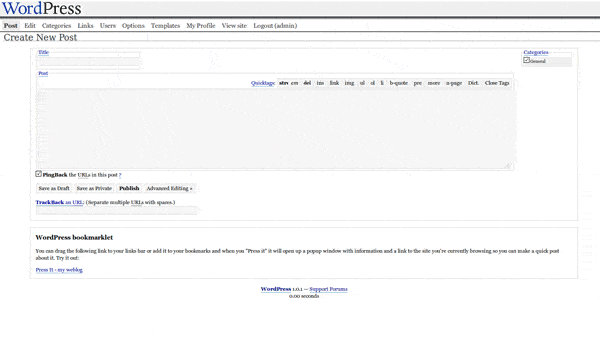WordPress launched 13 years ago today. That’s 13 years of blogs, businesses, and community.
The CMS has dramatically evolved over the years and is currently used by more than 25 percent of the entire internet. Needless to say, WordPress has come a long way since Matt Mullenweg and Mike Little teamed up to make blogging easier. We certainly wouldn’t be here without it.
Let’s look back at 13 of the biggest WordPress milestones over the last 13 years.
2003 — WordPress Was Released
There couldn’t be any milestones without the biggest. Thirteen years ago today WordPress officially launched when Mullenweg and Little released a blog post with a download link and a changelog as a fork of b2/cafelog. And just like that, WordPress was born.
2004 — Ryan Boren Created The Plugin System
Plugins are one of the defining attributes of WordPress, and one of the reasons it has become the world’s most popular CMS.
Plugins allow you to customize your site to fit your needs and the needs of your customer. The addition of the plugin system was a game changer for WordPress. The plugin repository currently boasts more than 40,000 free plugins.
2004 — GNU License
Without the GNU General Public License, WordPress wouldn’t be what it is today. The GNU GPL is a free software license that allows anyone to modify, share, and use WordPress for free forever. Because this will never change, users can continue to improve the software.
This open-source model is what sets WordPress apart from other software, and part of the reason it has become so successful.
2004 — First Update: Version 1.2 “Mingus” Released
Today, WordPress updates occur roughly four times a year.
Version 1.2 was the first major WordPress update, which included the addition of plugin support. WordPress has since seen more than 25 major updates, all of which have been named after jazz artists.
2005 — Automattic Launched
Automattic, the company behind WordPress.com, was founded in August 2005 by WordPress co-founder Matt Mullenweg, who stepped in as CEO in 2014 after his 30th birthday.
Since it was founded, Automattic has acquired several notable companies like Gravatar and most recently WooThemes, and now employs more than 450 people all over the world.
Several of Automattic’s employees contribute directly to the WordPress project by contributing to core, organizing WordCamps, or in various other ways.
2006 — First WordCamp
WordCamps have been instrumental in the growth of WordPress. Not only do they afford attendees the opportunity to meet in a face-to-face setting but they are also a great opportunity for WordPress users of all skill levels to learn from one another.
The first WordCamp kicked off in 2006 in San Francisco. More than 500 people RSVP’d to the event, which to date is still a good turnout for a WordCamp.
In 2015 alone there were 89 WordCamps all over the world, which is indicative of just how global WordPress has become.
2007 — Automattic Acquires Gravatar
Making a life online is a lot easier when you are recognizable to your colleagues and that is exactly what the acquisition of Gravatar did. The acquisition made all of the premium features of the service free and open to everyone who uses WordPress.
Your gravatar can now be associated with all of the work you do. Because everything is housed in a global database, you can grab your face from anywhere.
2011 — WooThemes Was Founded
WooThemes, the company behind WooCommerce, was founded in 2011 by Mark Forrester and Magnus Jepson. With more than 13.8 million downloads and 1 million active installations, WooCommerce is the single most popular ecommerce solution.
2012 — Themes Added To Dashboard
In 2012, themes were added to the dashboard so anyone could easily make a beautiful website for free.
Unlike other platforms that let you customize one main theme, WordPress makes it easy to arrange your site to accommodate a blog, store, or portfolio. When themes were added directly to the Dashboard, customizing was made even easier, especially for people with limited coding experience.
2015 — Plugin Directory Passes One Billion Downloads
Plugins allow users to extend and expand the functionality of their sites, and in that way sets WordPress apart from similar software. Even more than that, plugins act as their own business with thousands of developers making a living by creating plugins.
When the repository passed one billion downloads it proved the lasting power of plugins. They are a super accessible way to create an online business.
2015 — REST API Infrastructure Merged With Core
The REST API is a game-changer for WordPress, and in October 2015, the infrastructure was added to WordPress 4.4. Although there have been problems merging the rest, it is still a significant moment in WordPress’ history.
The REST API opens up endless possibilities. And although it isn’t fully merged in core yet, there are several examples of companies using it successfully — two most notable being the New York Times and Wired.
2015 — WordPress Powers More 25 Percent Of The Internet
On November 8, 2015, WordPress hit an incredible milestone, powering 25 percent of the internet. Since then, the number has risen to 26 percent and continues to grow.
When you consider the number of websites created every day, 25 percent is an incredible feat.
2015- WordCamp US
The first WordCamp US was held in December 2015 in Philadelphia. The event was a huge success, drawing roughly 2000 attendees from all over the world.
WCUS was one of the largest WordCamps ever.
Needless to say, it has been an incredible 13 years for WordPress, and all signs show no indication of it slowing down. We can’t wait to see what the next 13 hold.
Happy Birthday, WordPress!
Did we miss any of your favorite milestones? Share them in the comments below.


No Comments